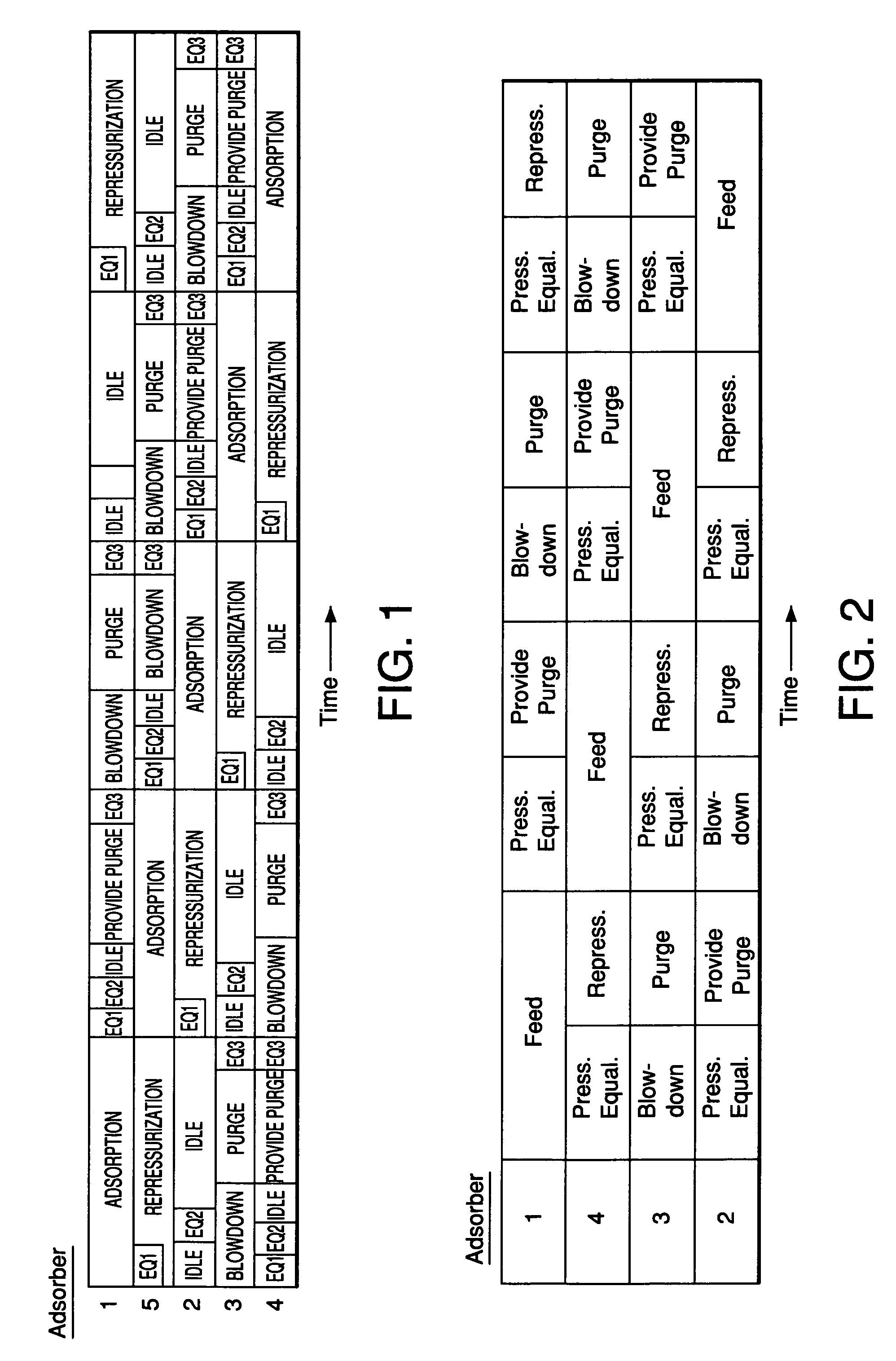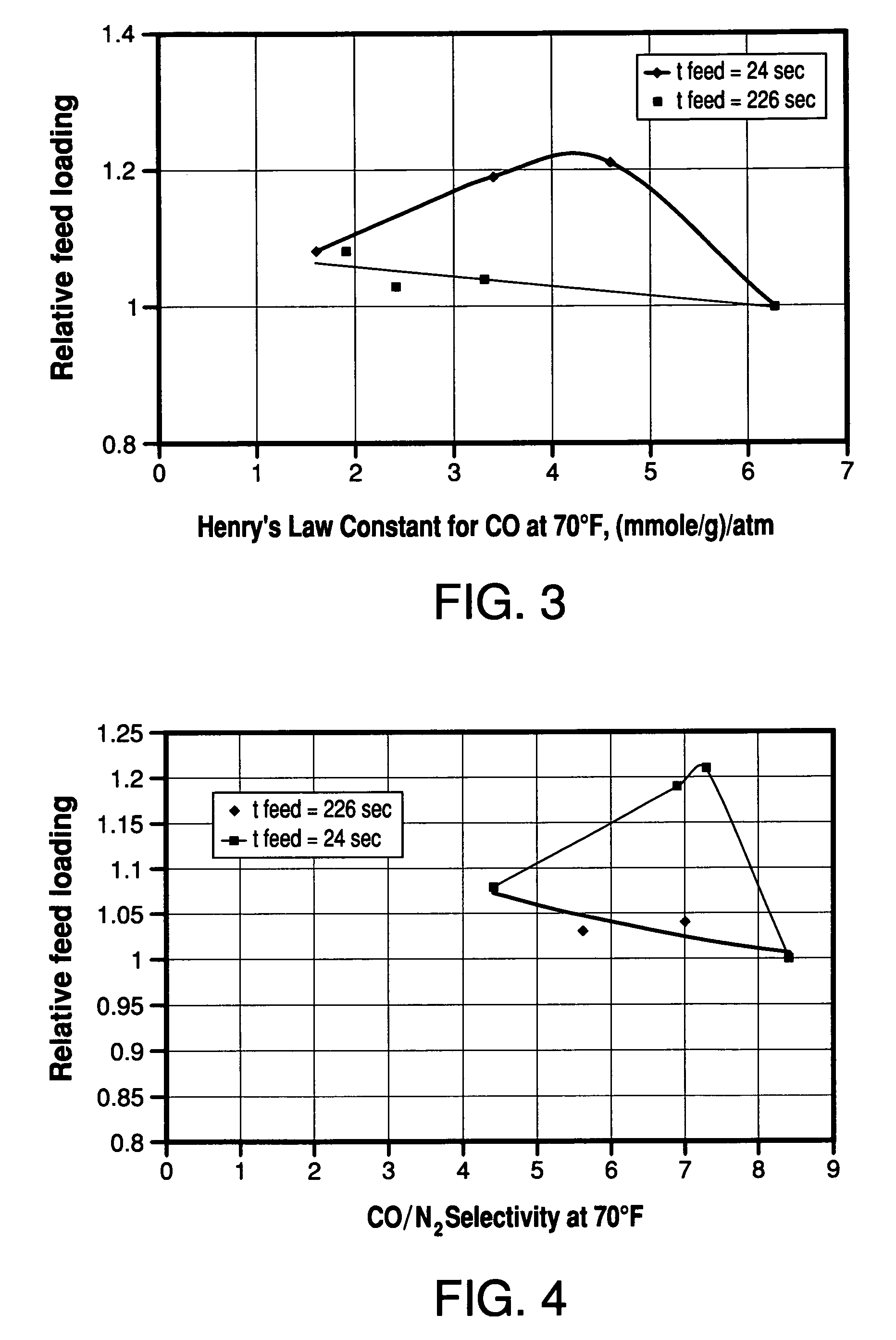Adsorbents for rapid cycle pressure swing adsorption processes
a technology of adsorbents and cycles, applied in the direction of hydrogen separation using solid contact, separation processes, dispersed particle separation, etc., can solve the problems of complex engineering challenges in the design and operation of these psa systems, and the overall cost of hydrogen from the integrated reformer/psa system includes both capital and operating costs
- Summary
- Abstract
- Description
- Claims
- Application Information
AI Technical Summary
Benefits of technology
Problems solved by technology
Method used
Image
Examples
example 1
[0065]A multiple-bed pilot unit was operated in a five bed configuration to measure H2 PSA performance for a feed gas composition of 14.9% CO2, 5.1% CH4, 5.5% CO, 0.25% N2 and 74.2% H2. The feed pressure was 440 psig and the feed temperature was 70° F. The 5 bed PSA cycle of FIG. 1 was employed having three equalization steps and a feed time of 266 seconds. The final H2 product contained 3 ppmv CO. Each bed contained 63 vol % activated carbon (Calgon type APHP) on the feed end of the bed and 37% zeolite on the product end of the bed. Both adsorbents had an average particle diameter of about 2 mm. Various final layer zeolites were tested including a highly exchanged binderless type 5A (CaA), a binderless type 13X (NaX), and two 5A samples with varying Ca exchange levels. Table 1 presents results of the testing in addition to the CO Henry's law constant (initial isotherm slope) at 70° F. The adsorption isotherms were measured in a standard volumetric adsorption unit. The lowest partia...
example 2
[0068]The multiple-bed pilot unit was operated in a PSA cycle using a four bed configuration to determine the effect of zeolite type on H2 PSA performance using reformer gas feed with a composition (in mole%) of 1% N2, 3% CO, 5% CH4, 19% CO2 and 72% H2. The PSA cycle used one equalization step and the cycle chart is given in FIG. 2. The feed pressure was 120 psig, the feed temperature was 70° F., and the feed time was 24 seconds. The adsorbent vessels were filled with 60 vol % activated carbon (Calgon type PCB) on the feed end of the vessel and 40 vol % zeolite on the product end of the vessel. In this rapid cycle testing, the average particle diameters were about 1 mm. The results of the testing are shown in Table 2 and FIG. 3.
[0069]
TABLE 2Henry's Law Constants and Relative Feed Loadings for CO(Example 2)KH CO @ 70° F.,Adsorbent(mmole / g) / atmRelative feed loading13X1.61.08BaX3.41.19Binderless 5A4.61.21(78% Ca exchange)Binderless 5A6.31.0(95% Ca exchange)
[0070]From the results shown ...
example 3
[0071]The performance of adsorbents for rapid cycle PSA applications typically is determined by their mass transfer properties. Clearly, the performance of adsorbents in PSA applications is a function of both the equilibrium and kinetic properties of the materials. Therefore, the N2 mass transfer coefficient for each adsorbent tested in Example 2 was measured by a volumetric uptake experiment at 70° F. The rate of N2 adsorption was fit to a linear driving force equation and the N2 mass transfer coefficient was determined. The linear driving force equation is dn / dt=k(neq−nt), where n is the amount adsorbed, t is time, neq is the amount adsorbed at equilibrium, nt is the amount adsorbed at time t, and k is the mass transfer coefficient. Table 3 shows the N2 mass transfer coefficients determined for the materials tested in Example 2.
[0072]
TABLE 3Mass Transfer Coefficients in Example 2N2 mass transfer coefficient,Adsorbent(sec−1)13X2.4BaX1.5Binderless 5A1.6(78% Ca exchanged)Binderless 5...
PUM
| Property | Measurement | Unit |
|---|---|---|
| feed time period | aaaaa | aaaaa |
| pressure | aaaaa | aaaaa |
| pressure | aaaaa | aaaaa |
Abstract
Description
Claims
Application Information
 Login to View More
Login to View More - R&D
- Intellectual Property
- Life Sciences
- Materials
- Tech Scout
- Unparalleled Data Quality
- Higher Quality Content
- 60% Fewer Hallucinations
Browse by: Latest US Patents, China's latest patents, Technical Efficacy Thesaurus, Application Domain, Technology Topic, Popular Technical Reports.
© 2025 PatSnap. All rights reserved.Legal|Privacy policy|Modern Slavery Act Transparency Statement|Sitemap|About US| Contact US: help@patsnap.com



